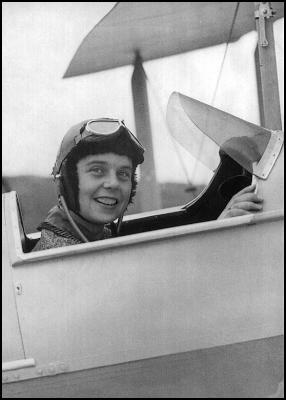Wanganui retirement village named after aviatrix
Media release – August 5, 2005
Ryman name their Wanganui retirement village after courageous NZ aviatrix Jane Winstone
Ryman Healthcare today announced it is perpetuating the memory of one of New Zealand’s greatest aviators Jane Winstone for their new retirement village in Wanganui.
The Jane Winstone Retirement village, on the famous old Sacred Heart College site, will be officially opened early next year.
Jane Winstone was the youngest New Zealand woman pilot at the time and later died, at 31, flying a Spitfire over England during World War 2.
Ryman Healthcare managing director Kevin Hickman said he felt Jane Winstone was a wonderful Wanganui pioneer female pilot to have the village named after.
``She was an incredibly brave woman and we feel honoured that we can name the retirement village after her,’’ he said.
``Jane Winstone was devoted to serving others, in peace and war, and Ryman Healthcare acknowledges this and her pioneering history in naming the Jane Winstone Retirement Village.
``By dedicating villages after female pioneers, we hope that memories are rekindled for residents and local communities of a generation of sacrifice and achievement.’’
Members of Jane Winstone’s family who remain in Wanganui said they are delighted that Jane is to be recognised by her peers as a great New Zealander.
Jane Winstone was born in Wanganui on September 24, 1912. Her father Arthur Winstone was a chemist.
At 16, while still a pupil at Sacred Heart, she took up flying as a hobby. She was a foundation member of the Wanganui Aero Club. Jane prized the distinction of flying in the first official plane from Wanganui airport.
She flew solo at 17, becoming the country’s youngest woman pilot at the time. She gained her pilot’s licence before turning 19.
Jane flew Charles Kingsford Smith’s Southern Cross and in NZ accompanied Jean Batten, after her record breaking flight from England to Australia in 1934. Jane was one of the four female pilots to accompany Jean Batten in flight to Wanganui, New Plymouth and Hawera.
Through flying, she became engaged to Angus Carr MacKenzie, the company secretary of a garage in Wanganui. He joined the air force and flew on raids over Germany and France, twice surviving forced landings in the sea. Jane Winstone was keen to help the war effort and joined ther Air Transport Auxiliary (ATA) in Britain. The auxilary ferried planes to air bases, delivered mail and secret documents and transported service personnel on urgent duties.
Shortly before leaving New Zealnd in June, 1942, she received word that MacKenzie her fiance was missing on a raid over Essen in Germany. His body was never recovered and he was later officially assumed ‘missing at sea’.
Jane Winstone arrived in England in August 1942. After passing her tests she was appointed to the ATA, one of five New Zealanders among the 90 women who served the ATA during the war.
She ferried a variety of planes which was hazardous work. She had to fly solo, radio contact was forbidden and sudden changes in weather meant unscheduled landings in difficult circumstances. Pilots also had to be on constant alert for barrage balloons. In January 1941 the famous English pilot Amy Johnson had been killed flying for the ATA.
Jane worked her way up to second officer and ferried Hurricanes and Spitfires in her everyday work. She also flew Supermarine Spitfires, Hawker Hurricanes and also a Gloucester Gladiator, for a film depicting the Battle of Crete.
By Early 1944, she was flying from the Cosford airbase in Shropshire, north west of London.
After taking off on February 10, 1944, the engine of her Spitfire failed at 600 feet. Her plane spun to the ground near Tong Castle and she was killed.
A talented pilot and courageous woman, Jane Winstone was one of 16 women from the ATA killed during the war. She was buried in the All Saints cemetery, Maidenhead, Berkshire, west of London.
The Jane Winstone Retirement Village is on a 2.7ha hectare site in one of the most prestigious areas of Wanganui, St Johns Hill.
An historic old Gothic style chapel built in 1918 on the site is being retained and protected by Ryman.
A heritage building, the chapel holds special significance for many in the local community and the chapel will remain available for special services.
Ryman is listed on the New Zealand Stock Exchange, recently reporting an annual net profit of $23.5million, up 28 percent on last year.
It employs 1300 staff and provides services to over 2500 residents throughout New Zealand.
ENDS

Jane
Winstone


 Athletics New Zealand: Connor Bell Breaks NZ Discus Record (Again)
Athletics New Zealand: Connor Bell Breaks NZ Discus Record (Again) Tertiary Education Union: UCOL Cuts Will Cause Lasting Damage
Tertiary Education Union: UCOL Cuts Will Cause Lasting Damage National Library Of New Zealand: Kate De Goldi Named Te Awhi Rito Reading Ambassador For Aotearoa
National Library Of New Zealand: Kate De Goldi Named Te Awhi Rito Reading Ambassador For Aotearoa Hikoi for Health: Healthcare Crisis Drives Cross-Country Protest | Hīkoi For Health Set To Begin
Hikoi for Health: Healthcare Crisis Drives Cross-Country Protest | Hīkoi For Health Set To Begin University of Auckland: New Zealand Professor's Paper Is One Of Century's Most-Cited
University of Auckland: New Zealand Professor's Paper Is One Of Century's Most-Cited Taite Music Prize: The 2025 Taite Music Prize Winner Is MOKOTRON - WAEREA
Taite Music Prize: The 2025 Taite Music Prize Winner Is MOKOTRON - WAEREA